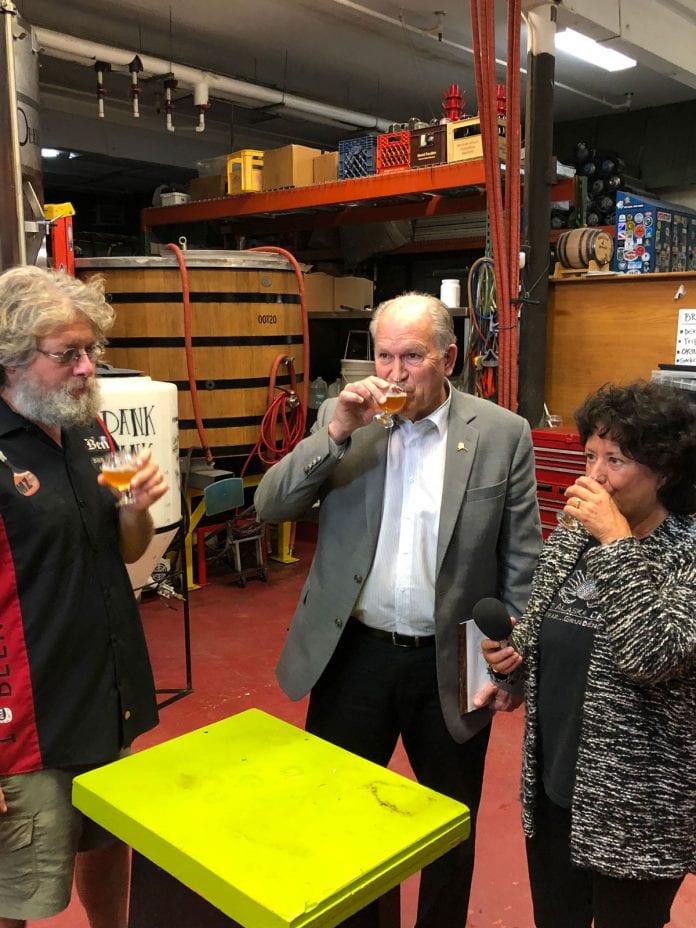
Gov. Bill Walker christened Alaska’s first kelp-based beer during a recent swing through Kodiak.
The beer was created at the Kodiak Island Brewery using local kelp from Kodiak Island Sustainable Seaweed (KISS), grown by Stephanie and Nick Mangini.
“Steph mentioned seeing a kelp craft beer on the internet and I told her to bring me 100 pounds,” said brewery “flow master” Chrissy Johnsrud, who created the new blend.
The beer, called Kelp Sea Level Gosé, is a sour, German wheat beer made with coriander and salt.
Brewery owner, Ben Millstein, said the seaweed was an easy fit.
“We used the amount of kelp that we thought would replace the amount of salt. It’s working really good,” he said.
The new beer was nearing its final stage as Millstein filled glasses with a small amount for tasting. He explained that there are over 150 different styles of beer and it is important to “calibrate one’s palate” before forming an opinion.
“Shift your mind into neutral and take a couple sips,” he instructed. “Then sit with it for 30 seconds or a minute and try not to judge. Let it in and let it go. Try to disengage and give it a calibration rest and then see what you think after that.”
The kelp beer had a pleasing briny taste and it won the governor’s approval.
“I like it. It’s very good,” Walker said, adding that he plans to add it to his kelp repertoire.
“I’ve got a kelp salsa story about how I helped get that Juneau product into Safeway, and now we have kelp beer to go with the salsa,” Walker said. “We are making it happen in Alaska as far as the blue economy. It’s right here in front of us.”
The Kelp Sea Level beer was set to be added to Kodiak Island Brewery’s 13-tap lineup any day.
More Gov goings on
While he was in Kodiak, Walker also signed House Bill 56, sponsored by Rep. Dan Ortiz, I-Ketchikan, that expands the state Revolving Loan Fund to create new financing options for fishing and mariculture businesses. He also re-established the Alaska Mariculture Task Force as an advisory body with a goal of growing a $100 million mariculture industry in 20 years.
“The fiscal crisis is on the wane. It should never have happened in the first place and we should never be in that position again. Now we can get back to building Alaska,” Walker said in an interview.
In terms of Alaska’s seafood industry, he said the biggest challenges stem from “unpredictability.”
“We have seasonal highs and lows, problems with returns,” Walker said. “It is very difficult for businesses to plan. One of our jobs is to make sure we provide the best data going forward as quickly as possible, so people and communities whose livelihoods depend on fishing have the assurance of a more stable future.”
The governor said our seas are “under assault” from a warming climate and off kilter ocean chemistry. That was the impetus, he said, for forming a climate change action committee which is scheduled to introduce recommendations next month that will build upon past policy initiatives and encourage new ideas.
Eat more fish leaves babies behind
Seafood nutrition experts were to gather in the nation’s capital on Sept. 14 for a State of the Science Symposium. The non-profit Seafood Nutrition Partnership (SNP) hosts the annual event as part of a public health campaign begun in 2015 aimed at getting Americans to eat more seafood.
The connection of omega rich seafood to brain health is a trending topic, according to the to the agenda.
“The brain and the retina in the eye are omega 3 organs. As calcium is to the bones, omega 3 is to the brain,” said Dr. Tom Brenna, professor of pediatrics and nutrition at Dell Medical School at the University of Texas/Austin and chair of the SNP advisory council.
Added to the symposium mix this year, Brenna said, are fisheries managers, aquaculture experts and environmental groups.
“And we guys on the medical nutrition side are thrilled,” Brenna said in a phone interview. “There is so much misinformation out there about the state of fisheries and management. Having folks who can speak authoritatively about what folks are doing in U.S. fisheries and
The Partnership works with local dieticians and uses educational programs and social media to get its health messages across. Brenna said have yet to come up with a catchy national brand.
“We don’t have a good a way of getting across the notion that seafood is such a delicious part of meals. Maybe we should have a contest to find a nice tag line that would identify seafood in the same way as ‘Got Milk?’ or ‘Beef, it’s what’s for dinner,’” he said.
A focus of the Seafood Nutrition Partnership is moms, but Brenna admitted that fish is missing from America’s baby food offerings.
“To be perfectly honest, I don’t know what the problem is,” he said. “It seems like it’s a consumer demand question – companies sell what the consumers demand and apparently, we have not done a good job in educating consumers about what they ought to be demanding for their kids.”
“In nutrition circles, for 30 years we have been discussing that when we transition a baby or toddler from breast milk or formula that contains omega 3s, they are transitioning to foods that have hardly any omega threes at all. And no fish,” Brenna added. “We should be weaning kids to the foods that are going to be important throughout their lives. And this may be a reason why they are not consuming seafood when they get older. Maybe this is something that we can work on with baby food manufacturers.”














